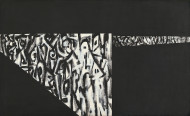
|
Norman Lewis Norman Lewis (artist) American, 1909 - 1979 Untitled (Alabama), 1967 oil on canvas overall: 114.9 x 186.7 cm (45 1/4 x 73 1/2 in.) Gift of the Collectors Committee 2009.45.1 Not on View |
This painting approaches its subject obliquely. Although there is no official title on record, Lewis' widow reports that he called it Alabama. Its composition reflects and exaggerates the shape of that state, which is a tapering quadrilateral with a "handle" at Mobile, where the border reaches the Gulf. Consider its date, 1967, and the fact that the artist was African American, and a theme begins to emerge. The hood of a Klansman emerges from a welter of black and white strokes. The two large forms have a violence to them, both in the way they meet the edge of the picture and in the way they cut off the marks within them. Think of a meat cleaver or a guillotine.
Lewis' "black paintings" (1946–1977) were shown in 1998 at the Studio Museum in Harlem. Untitled (Alabama) is the culmination of a subseries that includes American Totem (1960), Ku Klux (1963), and Processional (1964). In these works, compacted, flamelike strokes of white and black move and twist across the canvas, suggesting the ambulatory confrontations that punctuated the Civil Rights struggle. In Alabama in 1963, Martin Luther King was jailed, "Bull" Connor turned dogs and hoses on demonstrators, and four black girls were killed at a Baptist church.
As the sixties wore on and the Civil Rights and antiwar movements became more militant, artists increasingly turned to politics, such as in Barnett Newman's sculpture Lace Curtain for Mayor Daley (1968), with its barbed wire, and in Philip Guston's painting Courtroom (1970), with its Klansman and accusing finger. Lewis rarely resorted to such literal images, yet he had been working at the intersection of politics and art for years.
The wedgelike walls of Untitled (Alabama) reflect the geometric abstractions of the time—and the forms within them recall the gestural painting of the 1950s, particularly the work of Bradley Walker Tomlin and Mark Tobey—but they also foreshadow the work of Richard Serra and Maya Lin, two artists also concerned with the politics of human locomotion.
Lewis is often described as the main African American member of the abstract expressionist circle. This designation fails to capture his desire to reconcile abstraction with an urgent subject. Lewis may have disclaimed political efficacy for his art, but Untitled (Alabama), one of his greatest works, is unique in its historical ambition. It is the first work by the artist to enter the collection.

